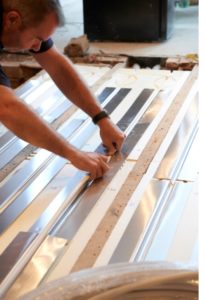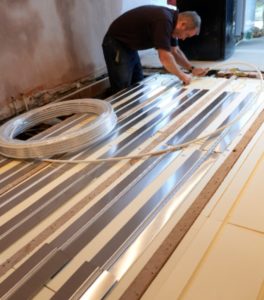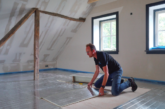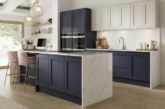Whilst still viewed as a luxury by some, underfloor heating (UFH) is becoming an increasingly sought-after solution for both new build and renovated homes. Steve Harris, Technical Services Engineer for Wavin Hep2O answers our questions about the technology.
Why should housebuilders consider underfloor heating (UFH)?
With pipes under the floor, a UFH heating system uses natural radiation to transfer heat into the room across the full floorspace, rather than from designated heating points like radiators. Not only does this mean more even heating, but it also negates the need for radiators than can be unsightly and impact the look and layout of a room.
Another key benefit for end-users is the cost savings they can see from using an UFH solution, as they have increased control over a more efficient heating system, meaning energy bills tend to shrink.
Are there any health benefits associated with UFH?
There are many benefits of UFH beyond just heating and aesthetics. One key area that shouldn’t be forgotten is the positive impact it can have on people’s health.
This heating system has little impact on air quality when compared with traditional convection heating systems which can circulate bacteria and dust. UFH can actually inhibit the growth of fungi and dust mites, reduce the circulation of airborne allergenic particles, and potentially help minimise the risk of room occupants developing respiratory issues. Furthermore, UFH keeps floor coverings warm and dry by circulating heated water beneath the surface.
 Can UFH also be installed on the wall?
Can UFH also be installed on the wall?
Despite the name, UFH isn’t exclusively for under floors. In fact, it can be installed into any part of a building envelope, including the walls of a room. This would provide an ideal solution in a room with a small surface area on the floor to maximise the potential heat output. This would be the case in a room such as a small bathroom where UFH would boost heating output for a space that would only be able to house a small – if any – radiator traditionally.
This solution enables great space-saving for smaller rooms like these, where the wall surface area is needed for cisterns, showers or sinks. However, it’s not advisable to opt for UFH in walls alone, as the heat output is higher when installed under floors.
There have been cases where UFH has been installed in the ceiling of a property and this can be hugely effective in building structures such as blocks of apartments. As the void of the ceiling is easily accessible for installation, the heating solution can be beneficial for both the room above and the room below. This kind of installation is more commonly found abroad in hotter climates because it works efficiently as a cooling system by circulating cold water. The pipework can be set into the concrete itself, allowing the complete building structure to be heated or cooled as required.
On the subject of using UFH to cool buildings, how does this work?
While it is uncommon in the UK, housebuilders and developers are increasingly looking for UFH cooling solutions over traditional air conditioning systems as spaces become smarter and summers warmer.
Underfloor cooling systems use chilled water, sourced via air or the ground which is circulated through the pipes to cool the building. The temperature is then reduced through the transfer of energy by radiant heat exchange to a temperature lower than the air above, creating a cooling effect.
 The components are identical for heating and cooling UFH systems, the only major difference is the control systems involved. Underfloor cooling requires more complex controls which automatically change from heating to cooling, as well as controlling the dew point when in cooling mode.
The components are identical for heating and cooling UFH systems, the only major difference is the control systems involved. Underfloor cooling requires more complex controls which automatically change from heating to cooling, as well as controlling the dew point when in cooling mode.
It is important to note that underfloor cooling systems can only work with a limited variety of flooring types. For example, stone, ceramic or LVT (Luxury Vinyl Tile). In such cases the floor temperature must never be cooled below the dew point because of the risk of condensation forming on the surface. This reduces any risk of homeowners injuring themselves on a slippery surface.
Are there any size constraints?
As the consumer demand for UFH in both new builds and renovations continues to increase, Wavin Hep2O offers a range of products suitable for both heating and cooling for projects of all sizes – from individual room renovations to full new build specification. Such systems are easy to install and come with market leading certifications and guarantees to meet current Building Regulations. Planners can also use Wavin Hep2O’s online tools to help provide the best quote and bill of materials, to ensure the very best solutions are chosen for a project.









